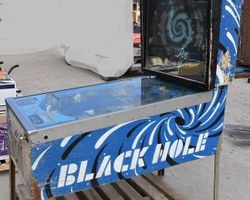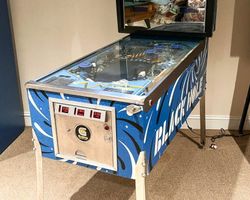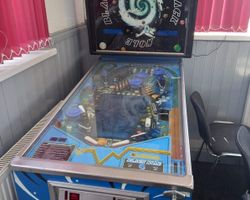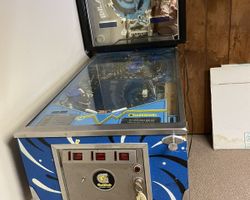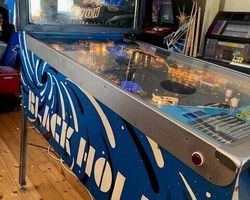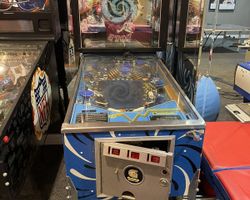Black Hole

Average Prices: USD $500 to $2,200
Produced: October, 1981
Production Run: 8,774 units
Machine Type: Solid State Electronic
MPU: Gottlieb System 80
Players: 4
Design by: John Buras, Adolf Seitz Jr.
Art by: Terry Doerzaph
The pinball machine "Black Hole" stands as a testament to ingenuity in a period of rapid technological advancement for the medium. Released by D. Gottlieb & Company in October 1981, this widebody machine, model number 668, quickly distinguished itself with features that redefined player interaction and visual presentation.
History and Background
D. Gottlieb & Company, a prominent name in pinball manufacturing, introduced "Black Hole" as a pivotal entry in their System 80 line of solid-state electronic games. The machine's production run of 8,774 units underscores its market presence and the company's commitment to pushing design boundaries. The central theme draws from popular science fiction and the mysteries of space, aligning with the public fascination with cosmic phenomena during the late 1970s and early 1980s. While not directly licensed, the machine's title and aesthetic resonate with the broader cultural impact of space-themed entertainment, including films of that era.
The creative forces behind "Black Hole" included designers Adolf Seitz Jr. and John Buras, who crafted the intricate gameplay mechanics and layout. Terry Doerzaph provided the artwork, infusing the machine with a distinctive visual style that captured the essence of deep space. A significant milestone for Gottlieb, "Black Hole" was their first solid-state game to feature both multi-level playfields and multiball, a complex combination that challenged both players and operators. Its innovative nature, particularly the pioneering use of a speech chip (the Votrax SC-01) for robotic voice synthesis in domestic versions, marked a technological leap. Despite its forward-thinking design, "Black Hole" was initially considered a high-maintenance game by operators due to its mechanical complexity, affecting its immediate popularity in arcades. However, its unique characteristics would eventually cement its place in pinball history. The machine even made a cameo appearance in the 1980s film Strange Brew, further integrating it into popular culture.
Signature Features and Design
"Black Hole" is defined by several standout features, each contributing to its singular identity. The most prominent is its multi-level playfield, specifically a groundbreaking lower playfield that is inverted and sloped away from the player. This design choice provides a novel perspective and a distinct challenge, requiring players to adapt their flipper control for the altered angle. This setup was a first in pinball, fundamentally altering player expectation and interaction.
Another defining characteristic, present in domestic versions, is the backglass animation. It features a double backglass with an infinity effect and a rotating disc, visually depicting astronauts being drawn into the black hole, enhancing the thematic immersion. The use of custom robotic speech, generated by the Votrax SC-01 chip, further amplified the sci-fi atmosphere. These synthesized voices delivered game prompts and commentary, a relatively new concept at the time, adding to the machine's futuristic appeal.
As a widebody pinball machine, "Black Hole" offers an expansive playfield, which contributes to a fast-paced and dynamic gameplay experience. The generous dimensions accommodate numerous targets and features, allowing for varied shot opportunities. Six flippers are strategically placed across both playfields, with four on the upper main playfield and two dedicated to the inverted lower playfield, providing comprehensive control over the ball's trajectory in both dimensions. The game also incorporates fluorescent digital displays, including a dedicated fifth display within the apron that serves as a bonus counter for points scored on the lower playfield, a clever integration of scoring feedback into the player's immediate view.
Playfield and Mechanics
The "Black Hole" playfield is a masterclass in layered design, compelling players to navigate two distinct environments. The upper playfield is expansive, characteristic of a widebody machine. It features six pop bumpers that create dynamic, unpredictable ball movement, and three slingshots that rebound the ball into play. Major shots include a kick target, a horseshoe lane, a spinning target, and a rollunder, all designed to keep the ball in motion and offer varied scoring opportunities. Two kick-out holes serve as collection points or entryways to specific game modes.
The lower playfield is the machine's true innovation. Sloping away from the player and accessed via specific shots on the upper playfield, it presents a unique challenge. This inverted orientation necessitates a different approach to flipper control, requiring players to aim with precision at objects that appear to recede from them. This level contains crucial drop targets: one 5-bank, two 4-bank, and one 3-bank, totaling 16 drop targets. These targets are central to progression, particularly for activating multiball. A cellar hole on this lower level is a high-risk, high-reward feature, often leading to significant points or progression toward objectives. The overall flow aims to draw the player into the "black hole" experience, creating a sense of descent and immersion. Artwork, designed by Terry Doerzaph, is consistent across both levels, utilizing deep space imagery, nebulae, and cosmic effects, with lighting reinforcing the cold, eerie atmosphere of the theme.
Gameplay Dynamics
"Black Hole" features gameplay dynamics that are both straightforward to grasp and demanding to master. The primary objective often revolves around activating and maximizing multiball, a three-ball frenzy that promises high scores. Achieving multiball is notoriously challenging, requiring players to strategically complete sequences of drop targets on the lower playfield. If a player drains balls from the lower playfield without completing the required objectives, the multiball mode is aborted, and play reverts to single-ball, adding a layer of risk to every descent.
The scoring system is robust, enhanced by the G-Force accelerator, which can double or even triple points scored on the lower level. The dedicated bonus counter display in the apron tracks these crucial lower playfield points, which are also subject to the overall bonus multiplier. This encourages players to venture into the inverted playfield despite its difficulty. Strategic play involves balancing risks: whether to pursue the high rewards of the lower playfield and multiball, or to focus on safer, consistent scoring on the upper playfield. Unique challenges include navigating the right outlane ball detour gate, which can sometimes save a ball from an otherwise fatal drain, offering a moment of relief in a demanding game. The game's robotic speech provides audio cues, reinforcing the objectives and the thematic experience as players strive to conquer the machine's gravitational pull.
Reception and Legacy
"Black Hole" garnered a complex reception upon its release, a dynamic that has evolved into a largely positive legacy within the pinball community. Its innovative multi-level design and the inclusion of robotic speech were widely praised as advancements, setting new benchmarks for pinball technology. The game's fast-paced, challenging nature, coupled with rules that were easy to understand but difficult to fully exploit, contributed to its addictive quality. The visual appeal of the space-themed artwork and the captivating backglass animation, particularly the spinning black hole effect, also received significant commendation, enhancing the overall player experience. The widebody design, a feature appreciated by many enthusiasts, facilitated a free-flowing and engaging play style.
However, "Black Hole" was not without its criticisms. Its high degree of difficulty and tendency for quick drains frustrated some players, who found the game brutal. The penalty for draining a ball in the lower playfield without meeting specific objectives was a common point of contention. Some found the repetitive nature of the background sounds and robotic voice to become tiresome over extended play. Mechanically, like some other Gottlieb System 80 games, it presented maintenance challenges, a factor that initially deterred some operators. A few players also felt the upper playfield was somewhat open or that the additional flippers were not always utilized to their fullest potential.
Despite these initial operational and gameplay frustrations, "Black Hole" has secured a significant place in pinball history. It is recognized as a pioneering machine that pushed the boundaries of design and technology, particularly with its inverted lower playfield and integrated speech synthesis. Its influence can be seen in subsequent multi-level playfield designs by various manufacturers. "Black Hole" is frequently regarded as a classic, admired for its unique character and the challenging, yet rewarding, experience it offers. Its distinctive features and bold design choices have ensured its enduring appeal among collectors and enthusiasts, solidifying its reputation as a memorable and important contribution to the evolution of pinball.
Sponsored Links
 Ebay Listings
Ebay Listings
 Auction Results
Auction Results
| Cost | Location | Date |
|---|---|---|
| USD $975 |  Colorado, United States Colorado, United States |
11 June, 2024 |
| USD $2,800 |  New York, United States New York, United States |
02 December, 2023 |
| USD $3,000 |  Ohio, United States Ohio, United States |
02 December, 2023 |
| USD $2,550 |  Minnesota, United States Minnesota, United States |
04 November, 2023 |
| USD $3,000 |  California, United States California, United States |
03 November, 2023 |
| USD $3,500 |  Georgia, United States Georgia, United States |
08 June, 2023 |
| GBP £2,500 |  United Kingdom United Kingdom |
31 May, 2023 |
| USD $4,200 |  Texas, United States Texas, United States |
03 March, 2023 |
| GBP £1,608 |  Nuneaton, United Kingdom Nuneaton, United Kingdom |
23 January, 2023 |
| USD $2,995 |  California, United States California, United States |
30 December, 2022 |


Private Policy · Search Website · Contact Us
As an eBay Partner, we may earn a commission from qualifying purchases made through links on this site, at no additional cost to you.
All trademarks and copyrighted materials remain property of their respective owners. All other content copyright 2007 - 2025 Pinpedia.

